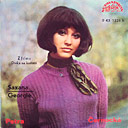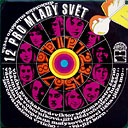Petra Černocká & the Karel Vlach Orchestra – Saxana
from 7 inch SP “Dívka na koštěti”, 1972, Supraphon 0431326, also on the compilation album “12 pro Mladý svět”, 1972, Supraphon 1131294
conducted by Karel Vlach, produced by Jiří Baur


original SP sleeve & the compilation LP sleeve
Dívka na koštěti (The Girl On The Broomstick) is one of my favorite Czech fairy-tale movies from the 1970s. Actually, it’s sort of a crossover genre because the director Václav Vorlíček was using elements from fairy-tales, fantasy and contemporary slapstick comedy, creating a fresh mix which still looks charming some 35 years later. I loved it then and I still love it now – in particular the lady who played the title role…
Petra Černocká (1949) is not an actor who sings but a singer who also used to act occasionally. She studied opera singing and piano on the Prague Conservatory. In 1967 she started to sing (and act) in the legendary Semafor Theatre. Her first record was her own song Ovečky (Little Sheep), recorded with a beat group of fellow conservatory students called Pastýři (The Shepherds). They recorded a couple of other 45s with folk-rock and pop tunes. In the early 1970s she joined the rock group Cardinals, but with the arrival of the “bubblegum-softie” Zdeněk Merta (from F.R. Čech’s Shut Up Orchestra) the band soon transformed to Kardinálové and started to play and record dull pop and C&W music – thus slipping out of my funky focus anyway. As for acting, apart from small roles in various TV and movie productions, the young witch pupil character Saxana a.k.a. “the girl on the broomstick” was her first major role. She’s nowhere to be seen singing in the movie though. According to a statement on her web site, originally she wasn’t even considered to sing the title song either.
That tune from the movie, Saxana, remains Černocká’s biggest hit and her signature song. It was composed by Angelo Michajlov with lyrics from Pavel Kopta. Michajlov was a Bulgarian who lived and studied music in Prague. Like Černocká, he also used to perform in the Semafor Theatre for some time. He wrote songs for Czech major pop artists like Marta Kubišová, Helena Vondráčková, Eva Pilarová or Václav Neckář. In the late sixties he began to work as a movie and TV score composer. Among his better known works were the scores for the popular 1980s children movie pictures Chobotnice z 2. patra (Octopuses From The 2nd Floor) or Lucie.
I have already briefly mentioned the Karel Vlach Orchestra as one of the best Czechoslovak big bands of the last century. That certainly applies if you dig swing, and the band history goes as far back as to the 1930s! Generally however, the orchestra’s ouput wasn’t necessarily funky in our sense; most of their recordings from the sixties on were anything else than progressive. Yet the boys in the band are still providing quite groovy backing on this particular track, although the overall production puts it rather closer to the “cheesy listening” genre. The 1970s orchestra line-up is unknown to me for most parts, but it’s not unlikely that Michajlov himself was sitting at the piano.
The 7 inch record is the movie “soundtrack”, although the b-side track, Georgie, has nothing to do with it (and it’s even much closer to cheese anyway). The song Saxana is available on various Czech CD compilations as it was one of the most popular songs of the 70s in Czechoslovakia. The movie itself is available on DVD with English subtitles and if you already like Czech children movies, you’re going to love this one too. (A sequel directed by Vorlíček again is currently being produced but I’m not holding my breath; the computer animated characters as they can be seen on this web site don’t promise anything good.) The aforementioned Various Artists vinyl compilation 12 pro Mladý svět (12 for the Young World magazine) will be tougher to find though; I’ve seen it only once so far – and that was the copy I have now. While the record doesn’t contain much “progressive” material either, there’s a couple of other, well, obscurities of historical character like few songs played and sung by the official and highly unpopular young communist “rock” group Plameny (The Flames) or a rare (and rather silly) post-Framus-Five bubble-gum outing by Michal Prokop. And drum break junkies might perhaps appreciate a less known pop tune by Olympic…
P.S. Dívka na koštěti läuft lief in der deutschen Fassung als Das Mädchen auf dem Besenstiel am 31.12.2006 um 6:00 Uhr im RBB.
The girl on the broomstick
Posted in Funky Czech-In
4 Comments
Comments are closed.

Hello Lukas!
It’s Kirill from Russia, do you remember me?
Very nice blog you have! Thank you very much for the great music and in-depth notes!!!
Ah, yes, Merry Christmas! :)
Cheers, Karel.
P.S. I have a blog, too. You’re welcome! I’ve added your blog on my links page! Cheers!
Welcome Kirill, yes I remember. You have purchased quite a lot of old Czech 45s from me some time ago… :)
I’ve added you to my Blog Roll, too. I’ll certainly “czech out” those posts containing Czech music.
OMG!!! It’s Saxana!!!
Thanks for this post, Lukáš!
I know, after first stumbling across ‘Funky Czech-In’ last night – I’m not sure why it’s taken so long for me to find it! – I sent an E-Mail to to you with a link to my own Blog, ‘Girls Of The Golden East’, on Female Pop from the time featured in ‘Funky Czech-In’ and from the former Eastern Bloc in general, but I think I have to respond to this post, since, about a year ago, funnily enough, I first encountered ‘Dívka na koštěti’ in the course of my ‘Girls Of The Golden East’ research, watched it (OK, so the Czech-language dialogue would had substantially gone over my head!) and thought to myself, “Well, this is a bit more entertaining than Harry Potter!” (and, dare I say, ‘scenic’, starring the stunning Petra Černocká!)
Given the fact that, at the time, I was looking into Petra after her name had been in the corner of my eye for her composition – and other great Czech Standard – ‘Koukej, se mnou si píseň broukej’, featured in the ‘oldies medley’ on Valérie Čižmárová’s eponymous 1975 LP, I think it can safely be said that Petra was far from the only stunner on the Czechoslovak Pop scene at the time. It gets BETTER than that, if possible!
I’d love to see some more Valérie Čižmárová in ‘Funky Czech-In’ – well, forget about the ‘more’ and concentrate on the ‘some’ ;-)
…an artist that blew into Prague in 1969 – aged just seventeen, having been in a talent show at sixteen – from a Hungarian-speaking family out in the ‘sticks’ of Michalovce – in the far East of Slovakia – like a force of nature and I think could almost be described as in a league of her own both in the voice and looks departments.
A thriller in every way!
I’ll be putting a link to ‘Funky Czech-In’ in ‘Girls Of The Golden East’, BTW.
The website quoted below was the recent Birthday celebration for Petra in ‘Girls Of The Golden East’. Doesn’t do too bad for 67! …a shame Valérie won’t get to celebrate a 67th Birthday :-(
Thanks for the inclusion after moderation, Lukáš!
Since you mention the name of the Director, Václav Vorlíček, that means, of course, that there is not only a connection between Petra Černocká and Valérie Čižmárová via the song, ‘Koukej, se mnou si píseň broukej’.
Three years after ‘Dívka na koštěti’, Václav Vorlíček also directed the wonderfully titled ‘Jak utopit Dr. Mráčka aneb Konec vodníků v Čechách’ (‘How To Drown Dr. Mráček, Or The End Of The Water Sprites In The Czech Lands’), featuring two songs in the background sung by Valérie – the track from her eponymous album, ‘Koňskou Dráhou’, that first really made me sit up and take notice of Valérie musically speaking, after having ordered that LP…where my ‘Girls Of The Golden East’ record-purchasing began…and playing it and being blown away by the beautiful hook line (it isn’t very often that an album track features in a shortlist of five all-time favourites, as it does on Aleš Korábek’s fan site and that such a track appears in the background of a film BEFORE it was released on vinyl) and ‘Tak měj mě rád’, the single that had kicked off Valérie’s classic year of singles-recording (1973), having been recorded on 9th January of that year. Furthermore, Valérie has, herself, a small part in the film as a singer.
It hasn’t only been the Pop Music of the former Eastern Bloc that has amazed and confounded me over this past year-and-a-half or so. The films and TV programmes have done so, too.